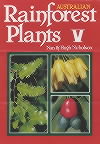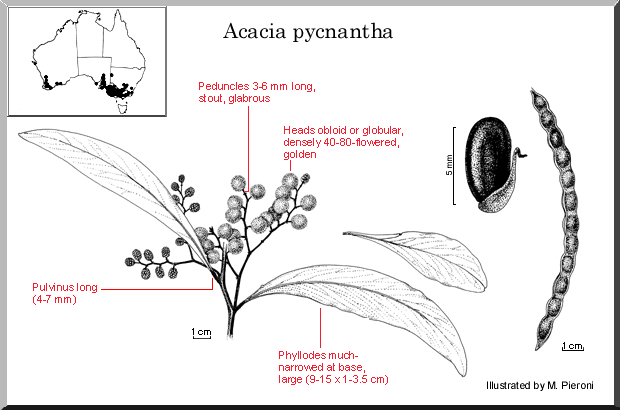|
[Front Page] [Features] [Departments] [Society Home] [Subscribe]

A Good Read
.....what's worth a look?
Reviews in this issue cover Australian Rainforest Plants V by Nan and Hugh Nicholson and WATTLE, a CD-ROM for identification of Acacia species. |
 |

 
Australian Rainforest Plants V
Nan and Hugh Nicholson
Published by Terania Rainforest Publishing.
Paperback, 72 pages. 132 colour photographs, AUD$16
Reviewed by Cherree Densley
Following the success of their previous four books, Nan and Hugh Nicholson present this fifth volume in the series which adds a further 114 species including trees, shrubs, ferns, vines and orchids. This series now illustrates and describes over 530 Australia's rainforest species - a prodigious effort.
 
Nan and Hugh's story is as fascinating as their books. More than 25 years has been spent on the north coast of New South Wales where their love and fascination of rainforest began. Intimate involvement with the conservation of rainforest plants pioneered the cultivation of their species. but their nursery interests have now been taken over by the production and sales of their books, farming and botanical consultation with Landmark Ecological Services. Nan, Hugh and daughters Terri and Elke all have a deep interest in environmental and social justice/human rights issues. In support of their principles, 10% of the sale of their books support conservation and human rights issues.
The quality of photography in Vol V is as superb as the previous four issues. I have never seen a more interesting photo as the one behind the front cover - the buttress roots of the Ficus nodosa (Rocky River Fig) is brilliant. You will delight in Nan's descriptions of each plant that contain a wealth of information and cultivation notes.
She writes, "The leaves are an elongated and exaggerated heart-shape and so softly hairy that they feel like puppy skin" - this is just a short part of the lovely description of the Abutilon oxycarpum (Small-flowered Abutilon). With the book comes the offer to send for the full and updated index of all five volumes. You will find the section of 'Rainforest seeds and their propagation' excellent and a must read for those who are interested in this aspect. I enjoyed reading every word and drooling over the photographs.
Highly recommended.
Reprinted from Growing Australian, newsletter of the Australian Plants Society (Victoria), March 2001.

 
WATTLE: Acacias of Australia
Bruce Maslin; Australian Biological Resources Study / Dept of Conservation & Land Management, WA
Windows CD-ROM
Published by CSIRO Publishing, PO Box 1139 (150 Oxford Street), Collingwood, Victoria 3066, Australia. Email: sales@publish.csiro.au.
CD and 24 page illustrated manual; $110
WATTLE is also available from: The Western Australian Wildflower Society
Inc. - wildflowers@ozemail.com.au
Reviewed by Jim Barrow
Ever tried to identify a plant using the usual branching keys? You know the problem. You come to an impossible question. So you have to check both branches - and then you come to another impossible question.
It doesn't have to be this way. There are computer programs that let you answer the questions in any order you choose. We now have such a program for Australian acacias: "Wattle, Acacias of Australia". You can buy it as part of a package together with Flora of Australia volumes 11A and 11B which describe the acacias, or you can buy it on its own.
It comes as a CD. You load the program, but much of the data remains on the CD so you need to have it in your CD drive to run the program properly. No chance of sharing the program amongst several users - and of course we wouldn't do that would we.
You can use it simply as an information source. For example to look up the description of an Acacia the name of which you know but want to know more about - say its distribution or its flower colour. Or you can use it to identify a wattle.
The starting screen tells you that there are 1165 taxa to choose from and invites you to start selecting from an initial list of 28 characters. You can choose them in any order you wish but you also have the option of organizing the characters into the most efficient sequence. You have two types of characters: state characters and numerical ones. An example of the first kind is "Foliage type": what kind of "leaves". Examples of the second kind are the length of the leaves and the width of the leaves.
Suppose you start by specifying the "Foliage type". If you click on the words, the list expands to let you choose amongst the four foliage types. Not sure what the words mean? Click on a little purple triangle and up comes an informative diagram. Still not sure? Click on the "i" button or drag the thumbnail pic into the open book.
For phyllodes up comes the adjacent pic plus some description to tell you something about this choice.
If you decide you have indeed got phyllodes you will find that there are now 1050 taxa remaining and that you have discarded only 115. You can then go on to describe the phyllodes in detail, specifying their length, width, their apex (pungent or not), their cross section and the properties of the nerves.
At each question a little diagram can be brought up. I especially liked the diagram to describe pungency of the phyllode tip - see right.
So if you don't know, for example, what nerve anastomoses are, the diagram makes it clear (see below). The script, which I haven't reproduced here, advises you how best to determine this character.
If you had chosen "bipinnate" for the foliage type a different set of characters describes these leaves.
Other characters include the shape of the inflorescence (cylindrical, ovoid, spherical). Again you can drag the thumbnail into the open book to get more details as shown in the illustration below.
You can go on to describe characters such as the length and hairiness of the flower stalk (peduncle), the characteristics of the pod, and of course the region in which the specimen was found. (Use this one with care. It's very powerful of course but your specimen could be a garden escape or a new record for that region.) As you answer each question, the number of taxa remaining decreases.
|
Inflorescence shape
Determine shape of the inflorescence.
This powerful Character is best determined when flowers are at anthesis* or in mature bud.
On fruiting specimens the inflorescence shape can often be inferred from inspecting the disposition of flower scars on the receptacle**, but be careful: taxa with globular heads commonly have obloid receptacles (select both Globular and Obloid/ellipsoid if in doubt);
In taxa with cylindrical spikes the receptacle above the uppermost pod commonly withers and the receptacle therefore appears artificially shortened (thus, for shortly elongated receptacles it is prudent to select both Cylindrical and Obloid/ellipsoid).
Globular.
Flowers aggregated into spherical (globular) heads.
Sometimes it is difficult to decide if heads are Globular or Obloid/ellipsoid: if in doubt select both States.
*Anthesis: when the flowers are fully expanded, i.e. stamens exserted.
**Receptacle: the terminal region of the peduncle upon which the flowers are inserted.
|
 |
The 28 "fast find" characters on the initial list are pretty powerful and will often get you down to a manageable smallish number. But if not, or if you have only an incomplete specimen, then you can increase the number of characters, for example, deciding to add vegetative characters (tree, shrub, prostrate) or details of the flower.
Once you have got it down to a few remaining taxa, you can hit the "bingo" button. This one tells you which characters differentiate amongst the remaining taxa. Choose that one character and "bingo", you've got it!
If you still can't decide, you can turn on the "slide show". This scrolls through the pics of the remaining taxa giving you a fair chance of deciding. Eventually of course you must check the full description. You click on the remaining taxa to bring up the screed describing each taxa in detail. It has: common names, a botanical description, notes on occurrence, some general remarks, type of accepted name, notes on synonymy, where you can see illustrations, and representative collections.
You also get a thumbnail of a drawing of important characteristics of each taxon. Click on this and you get a nice clear drawing, mostly by Margaret Pieroni, with the important characteristics highlighted - see the example for Acacia pycnantha below.

Is it any good? Yes it is! Suffice to say that I actually identified several specimens fairly painlessly. However, you do have to have the specimen in your hand if you are going to answer the questions posed. The printed manual is small, but effective and there is an on-line version as well. Of course you have to read it - as I had to to prepare this review! The program is fairly intuitive, so it is tempting to just have a go, but then you don't know about such tricks as "Bingo" or the slide show.
How does it compare with a book? Well the two volumes of the Flora of Australia are pretty big and heavy so it's hard to sustain the argument that it would be easier to use the book in the field. If you had a lap-top computer you really could use the program in the field fairly easily. Now if we only had similar programs for the rest of the flora!

[Front Page] [Features] [Departments] [Society Home] [Subscribe]
Australian Plants online - December 2001
Association of Societies for Growing Australian Plants
|










